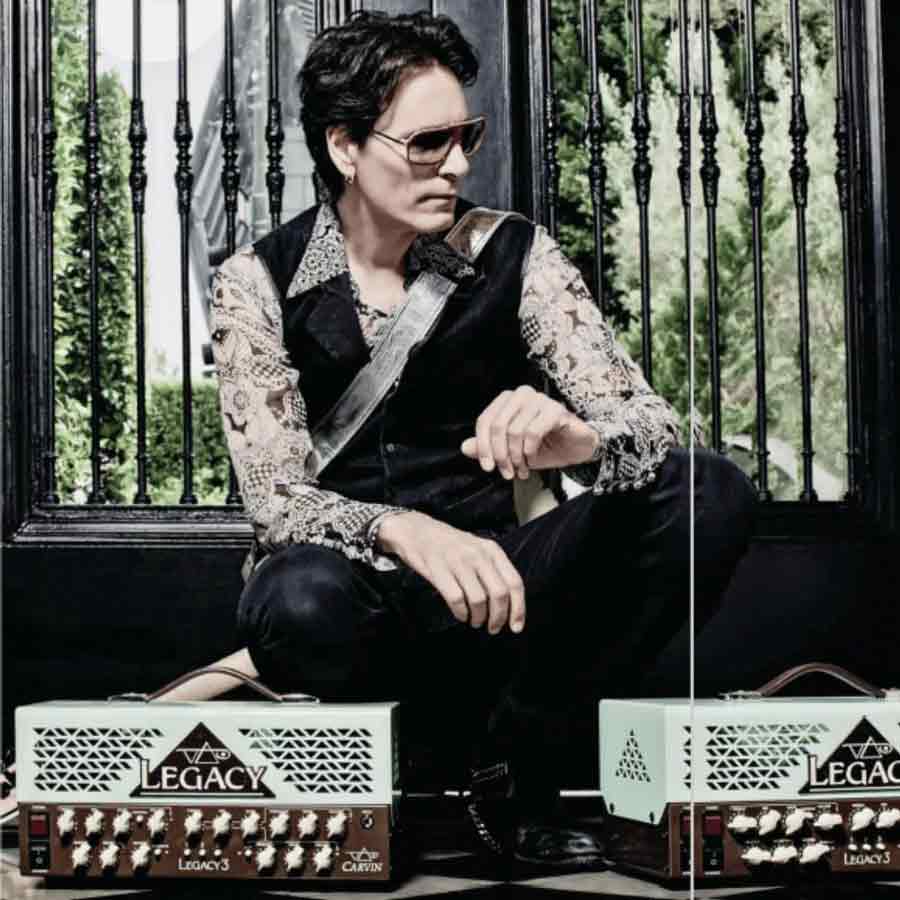Steve Vai gives us the inside story of the development of his new Carvin Legacy 3 amp, plus his views on the whole signature concept… by Simon Bradley
Originally published In guitarist magazine August 2012
Steve Vai is having a big year. Not only is his latest solo album The Story Of Light in the can and ready for release in August, but there’s also the third version of his signature Carvin Legacy 3 amp poised to hit the shelves . The ever-affable guitar genius calls us from his rehearsal space to talk tone, gear, and Eddie Van Halen.
How did your relationship with Carvin begin all those years ago?
“When I moved out to California in around 1980 to start working with Frank [Zappa], Carvin gave me my first stack. It was an X1O0B head with two 4 x 12 cabinets and it was amazing for me to have this giant stack. I used it for many years until I eventually rambled off into various other kinds of amplifiers, and I got back together with Carvin in the late nineties.”
What did you want from a signature amp?
“I’ve always tried to find the sound or feel of the music that really resonated with me, which is one of the freedoms an artist has, that anybody has, really. I was looking for a smooth and friendly, yet powerful sound, and for years I used conventional Marshalls or whatnot that had that historic sound. But, when you’re playing instrumental guitar, where it’s either a melody or a solo all night, you don’t want to beat people over the head with a grinding, piercing tone.”
And so the first Legacy amplifier began to take shape…..
“Well, I got very forensic about it. We tried different tubes and I’d research how they worked. I discovered that when you build a motherboard that’s hand-wired, all the soldering and joints have a lot more integrity. It’s expensive to do that, but Carvin was able to make this hybrid that’s much more robust than most other amps. “One of the great things about Carvin is that the firm can pack a lot into an amplifier without a great expense because it’s a home-grown corporation, so to speak. The amp packed quite a wallop and had a tone that was very friendly to me, so that became the Legacy 1”
How did that original amp transform into the Legacy II?
“I was very happy with the Legacy I but, because we’re always trying to reinvent the wheel, we decided to come up with another version. With the Legacy II, I turned to a different engineer and basically rebuilt the engine of the amp by adding another gain structure. It worked for a couple of years, but my ear was gravitating back towards the comfort I’d had from the Legacy I.”
And from there, the Carvin Legacy 3?
“Sometimes you don’t know what you need until you go to war: the stage is the battlefield. Gear may have a particular feel when you’re in the rehearsal room, but when you go from gig to gig there’s never really any consistency. So one of the big chores was to get the Legacy 3 to be [tonally] consistent.”
How about the 3’s small size?
“The new trend is ‘powerful but small’, so we constructed the amp within a framework that’s much smaller than what you can usually pack a 100-watt amplifier into. It’s easy to carry but it still retains all of the integrity. So, you know me and my bizarre colours,I wanted to do something a little more exotic, so we put lights inside ofit. You know, they’re only aesthetics but it’s part of what attracts me.”
Do you still use the Fractal Axe-Fx?
“The way my sound is, I try to avoid digital gear but if you want delay, you have to go with digital. I use a fair amount of stereo delay and I needed to find a unit that gave me that delay yet also had a clear and clean cross-trhough, as if you are in bypass mode The Axe-Fx was the closest I could find that not only gave me the effects but also retained the sound quality of the original tone. It’s really a beast; you can discover the universe with that thing [laughs].”
What do you think the appeal of the signature amp is for people?
“One obvious reason is that they like the artist and the tone, and that they maybe want to have a starting point. But then there are others who will go out of their way not to buy [a signature product] because a particular artist has designed it; some people will steer clear of anything Vail And that’s okay, as they’ll find something else.”
Do you think people will assume they will need an Ibanez JEM too?
“Well, that’s a very interesting point, and I think the same thing applies. People buy guitars for various reasons, and the JEM’s a classic now; it’s 25 years old. It was a collectible, in a sense, as it hasn’t changed; I know people who have 40 JEMs! Maybe they’re Steve Vai fans, but they’re devoted to the guitar.”
What do you feel is the heart of tone?
“I’ve discovered very clearly that the tone is in your imagination, in your head; it’s not necessarily based on the gear of another person. I was sitting in my studio recording and I was using my amp, my guitar, all my effects, and Edward Van Halen came by. At the time we were friends, we were hanging out, and he picked up my guitar to show me something he was working on. It was remarkable; he sounded exactly like Edward Van Halen! It was very obvious to me that the tone was in totally in his fingers and in his head.”
Let’s hope that secret doesn’t get out …
“If it does, hopefully more people will start thinking about their tone! [laughs]”
